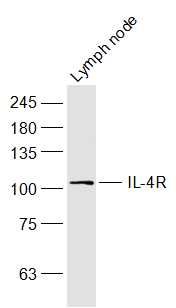产品货号 : mlR23579
英文名称 : IL-4R
中文名称 : 白细胞介素4受体抗体
别 名 : Interleukin-4 Receptor; 582J2.1; CD124; CD-124; CD 124; IL 4R alpha; IL4RA; Interleukin 4 receptor alpha chain; MGC118473.
研究领域 : 细胞生物 免疫学 细胞膜受体 细胞表面分子
抗体来源 : Rabbit
克隆类型 : Polyclonal
交叉反应 : Mouse, Rat,
产品应用 : WB=1:500-2000
not yet tested in other applications.
optimal dilutions/concentrations should be determined by the end user.
分 子 量 : 88kDa
细胞定位 : 细胞膜 分泌型蛋白
性 状 : Lyophilized or Liquid
浓 度 : 1mg/ml
免 疫 原 : KLH conjugated synthetic peptide derived from rat IL-4R:111-210/801
亚 型 : IgG
纯化方法 : affinity purified by Protein A
储 存 液 : 0.01M TBS(pH7.4) with 1% BSA, 0.03% Proclin300 and 50% Glycerol.
保存条件 : Store at -20 °C for one year. Avoid repeated freeze/thaw cycles. The lyophilized antibody is stable at room temperature for at least one month and for greater than a year when kept at -20°C. When reconstituted in sterile pH 7.4 0.01M PBS or diluent of antibody the antibody is stable for at least two weeks at 2-4 °C.
PubMed : PubMed
产品介绍 : This gene encodes the alpha chain of the interleukin-4 receptor, a type I transmembrane protein that can bind interleukin4 and interleukin 13 to regulate IgE production. The encoded protein also can bind interleukin 4 to promote differentiation of Th2 cells. A soluble form of the encoded protein can be produced by an alternate splice variant or by proteolysis of the membrane-bound protein, and this soluble form can inhibit IL4-mediated cell proliferation and IL5 upregulation by T-cells. Allelic variations in this gene have been associated with atopy, a condition that can manifest itself as allergic rhinitis, sinusitus, asthma, or eczema. Two transcript variants encoding different isoforms, a membrane-bound and a soluble form, have been found for this gene. [provided by RefSeq, Jul 2008].
Function:
Receptor for both interleukin 4 and interleukin 13. Couples to the JAK1/2/3-STAT6 pathway. The IL4 response is involved in promoting Th2 differentiation. The IL4/IL13 responses are involved in regulating IgE production and, chemokine and mucus production at sites of allergic inflammmation. In certain cell types, can signal through activation of insulin receptor substrates, IRS1/IRS2.
Soluble IL4R (sIL4R) inhibits IL4-mediated cell proliferation and IL5 up-regulation by T-cells.
Subunit:
The functional IL4 receptor is formed by initial binding of IL4 to IL4R. Subsequent recruitment to the complex of the common gamma chain, in immune cells, creates a type I receptor and, in non-immune cells, of IL13RA1 forms a type II receptor. IL4R can also interact with the IL13/IL13RA1 complex to form a similar type II receptor. Interacts with PIK3C3 (By similarity). Interacts with the SH2-containing phosphatases, PTPN6/SHIP1, PTPN11/SHIP2 and INPP5D/SHIP (By similarity). Interacts with JAK1 through a Box 1-containing region; inhibited by SOCS5. Interacts with SOCS5; inhibits IL4 signaling.
Subcellular Location:
Cell membrane; Single-pass type I membrane protein. Isoform 2: Secreted.
Tissue Specificity:
Isoform 1 and isoform 2 are highly expressed in activated T-cells.
Post-translational modifications:
On IL4 binding, phosphorylated on C-terminal tyrosine residues. Phosphorylation on any one of tyrosine residues, Tyr-575, Tyr-603 or Tyr-631, is required for STAT6-induced gene induction.
The soluble form (sIL4R/IL4BP) can also be produced by proteolytic cleavage at the cell surface (shedding) by a metalloproteinase.
Similarity:
Belongs to the type I cytokine receptor family. Type 4 subfamily.
Contains 1 fibronectin type-III domain.
SWISS:
Q63257
Gene ID:
25084
Important Note:
This product as supplied is intended for research use only, not for use in human, therapeutic or diagnostic applications.
产品图片












